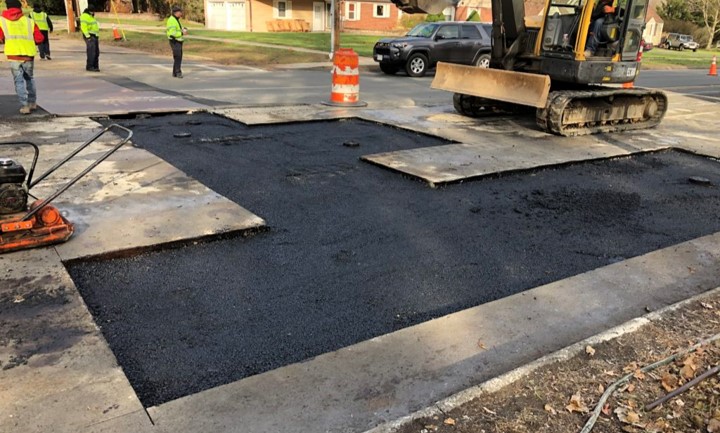This piece was originally published in The Detroit News, “Opinion: Don’t keep tearing up public infrastructure because of inefficiency.”
Author: Eric Paul Dennis, PE (epdennis@crcmich.org)
In a Nutshell:
- Public roads are more than just transportation corridors. Roads are often built within a right-of-way that is also used by other types of infrastructure and utilities.
- Construction projects that do not coordinate efforts between the various users of a right-of-way can lead to wasted costs, such as digging up new roadway pavement to replace a water main.
- Infrastructure owners and utilities can save money and avoid disruptive construction projects by collaborating on “dig once” policies and “subsurface utility engineering.”
Building and maintaining public infrastructure and utility networks can be costly and disruptive. When the public is asked to contribute to the cost of these projects, it wants to know that the funding is used efficiently. Collaboration in asset management and project design is becoming more common and should be encouraged for all participants.
Combine Projects to Avoid Wasted Efforts
A road is more than a road. The road sits within a piece of real estate called a right-of-way (ROW). This ROW is owned by a government such as a state, county or city. Within that public ROW is not only the road pavement, but often multiple types of public infrastructure and public or private utilities, each with its own set of restrictions, responsibilities and rights.
When a road is closed for construction, the project often has nothing to do with the road, but is to repair, replace, or install some utility under the road. For example, it is not unusual for a road to be repaved only to have a water main or sewer repair a year or two later – ripping up and replacing sections of new pavement.
Image: This water main replacement was not coordinated with road construction.

Obviously, this is disruptive and inefficient. Government agencies and utility companies are aware of this issue. In recent years, the phrase “dig once” has become a popular mantra to capture the idea of coordinating across agencies to improve project design and reduce construction costs.
When a road is closed for construction, the work is often related to some sub-surface utility rather than the road itself.
The “dig once” approach is most often referenced as a strategy to expand broadband availability. The materials and labor costs required to install communications lines can be multiple times over the fiber optic cable itself. To lower the costs of broadband service expansion, the federal government encourages road agencies to adopt “dig once” construction standards that include installing empty conduit and frequent access points within the ROW as a component of road projects. This would allow telecommunications companies to run cable through these unused conduits at highly reduced cost.
The “dig once” concept can be further extended to all infrastructure and utilities that share the ROW. For example, it could be used to underground electrical powerlines and avoid future storm-related power outages.
Plan Ahead with “Subsurface Utility Engineering”
Most construction projects commence with only a vague idea of what lies beneath the surface. This leads to frequent utility disruptions and cost overruns.
The benefits of “dig once” can be amplified through coordinated subsurface utility engineering. This approach emphasizes obtaining as much knowledge of underground utilities as possible prior to project design using ground-penetrating radar and non-destructive excavation.
Readers may be surprised to learn that most construction projects commence with only a vague idea of what lies beneath the surface. Construction plans typically include disclaimers warning the contractor to dig carefully. Contractors and project engineers are often surprised by what they find. These are rarely good surprises. Such practices lead to frequent utility disruptions, cost overruns, and timeline extensions.
If project engineers take the time to identify subsurface conditions and locate utility runs with relative certainty, they can then coordinate with utility owners as appropriate to reconstruct the ROW so that all deficiencies are addressed.
Successful “dig once” projects typically result from individuals going above and beyond their job descriptions to build relationships and establish cooperative frameworks. Such efforts should be supported by purposeful policy.
The projects can also include relocating each utility within a shared corridor, along with vacant conduit runs for future utilities and sufficient access points to install and maintain utilities as needed. When projects are finished, detailed “as-built” information should be collected, archived and integrated into broader asset management efforts.
Complete subsurface utility engineering can add substantial costs to a project and may seem only worthwhile in dense urban ROWs. However, this is an investment in the future. Subsurface utility engineering can enable near-literal “dig once” management of the ROW such that any future work can be completed without any unnecessary excavation. These principles can be adopted to varying degrees to fit the context of the project.
The benefits of “dig once” and coordinated subsurface utility engineering are well-understood. Yet, such cross-agency coordination is relatively rare because of the up-front investments of time and resources required.
Image: Road construction could include a joint utility corridor to reduce cost and disruption of future utility work (Source: Columbia Telecommunications Corporation)

Public infrastructure projects are difficult to manage in the best of times. They require coordination between infrastructure owners, consulting engineers, contractors, multiple subcontractors and a variety of others. Different entities pursue their own objectives on various timelines, with various priorities and funding mechanisms. They are responsible to different constituencies, stakeholders or even shareholders. Expanding the scope of a project can introduce complications.
Agencies are often hesitant to voluntarily pursue “dig once” principles unless the benefits of coordination are clear. Even when the benefits of coordination are clear from a perspective of broad public interest, it may not be obvious from any individual viewpoint. Successful “dig once” projects result from individuals going above and beyond their job descriptions to build relationships and establish cooperative frameworks.
At a minimum, whenever any significant capital investment is planned for a ROW, all existing and potential ROW users should be notified as soon as possible to enable potential cost-saving collaborative projects. The challenge is making this happen.
Progress in Michigan
The benefits of “dig once” and coordinated subsurface utility engineering are well-understood. Yet, such coordination is relatively rare because of the up-front investments of time and resources required.
There are several “dig once” success stories from Michigan agencies. For example, the Detroit Water and Sewerage Department and the city of Detroit General Services Department are collaborating on an extensive stormwater management project in Rouge Park that will also include drinking water and sanitary sewer upgrades. The excavated soil will be used in a redesign of Riverside Park next to the Ambassador Bridge.
While such examples remain relatively rare, the opportunities for collaboration are extensive. Many people are working hard to make them more common. Three efforts stand out:
► In the Detroit metro area, the Southeast Michigan Council of Governments (SEMCOG) has recently established the Capital Improvement Project Coordination Tool. This geodatabase allows all types of infrastructure and utility owners to upload their capital improvement plans to enhance collaboration with other infrastructure owners.
► On the west side of the state, the Grand Valley Metropolitan Council oversees a consortium of communities and utility providers called REGIS (an acronym for Regional Geographic Information System). This system provides a database and suite of applications and interfaces to satisfy the spatial data management needs of all participant members. REGIS has been active more than 20 years and served as the template for a statewide effort overseen by the Michigan Infrastructure Council (MIC).
► The new MIC platform is called the “Dig Once Project Portal.” The Portal allows public and private asset owners to document future construction locations/dates across transportation, water, utilities, and communications infrastructure. Thousands of projects have been added to the portal from infrastructure and utility owners across the entire state of Michigan.
Image: SEMCOG’s Dig Once coordination tool provides a platform for infrastructure and utility owners to coordinate efforts.

Keep Up the Good (Coordinated) Work!
The opportunities for cost-saving collaboration are extensive.
These platforms are not a complete solution to “dig once” planning or subsurface utility engineering, but they can facilitate such efforts. It would benefit infrastructure and utility owners to embrace these projects.
Public policies should encourage them further. Such efforts will be essential for Michigan to establish infrastructure design and management practices that are resilient and sustainable for decades to come.

